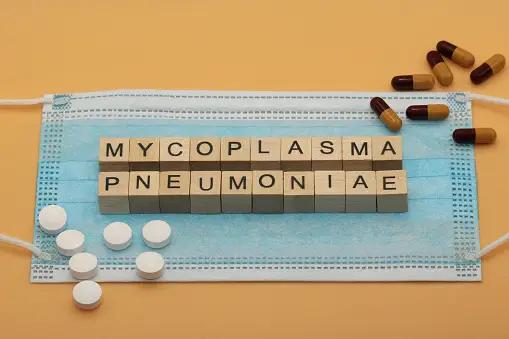
This study utilized data from the CDC’s National Syndromic Surveillance Program (NSSP) and the New Vaccine Surveillance Network (NVSN) to investigate Mycoplasma pneumoniae infections before, during, and after the COVID-19 pandemic. M. pneumoniae infections exhibit significant cyclical increases every 3 to 5 years, attributed to shifts in the dominant circulating strain. Treatment typically involves macrolide antibiotics, although resistance rates vary.
Analysis showed a reduction in diagnoses related to M. pneumoniae from 1.15% in the period before the pandemic to 0.35% during the pandemic, followed by a rise to 0.89% after the pandemic. In a similar trend, data from NVSN indicated a decrease in M. pneumoniae positive tests from 1.2% before the pandemic to 0.04% amidst the pandemic and a subsequent increase to 0.53% following the pandemic. Of 14 specimens tested for macrolide resistance, 13 were identified as susceptible.
“Data collected by NSSP and NVSN demonstrate that the percentage of M. pneumoniae diagnoses and positive M. pneumoniae test results decreased during the COVID-19 pandemic,” according to the CDC. “The percentage of diagnoses and positive test results have increased since September 2023 but remain below pre-pandemic levels.”1
3 Key Takeaways
- This study highlights the pandemic’s overarching effect on the epidemiology of respiratory infections.
- M pneumoniae infections are characterized by their cyclical increases every 3 to 5 years, a pattern that was disrupted by the pandemic.
- The study acknowledges limitations, including the reliance on surveillance data and a small sample size for resistance testing.
The NSSP dataset included data on emergency department visits for pneumonia, covering a network of facilities across the US with a focus on children and adolescents. The NVSN monitored acute respiratory infections in this demographic. This effort involved testing for M. pneumoniae at 4 sites, with an additional 3 sites conducting tests for diagnostic purposes. The study was segmented into 3 periods, pre-pandemic (January 2018 to April 2020), during the pandemic (May 2020 to August 2023), and post-pandemic (September 2023 to December 2023). Furthermore, the infection specimens testing positive at 4 NVSN sites from September 2023 to January 2024 were subjected to molecular analysis at the CDC to determine macrolide resistance.
The limitations of the study include the dependence on surveillance and laboratory data, which might not encompass all instances of the infection. Moreover, the limited number of specimens evaluated for macrolide resistance constrains the applicability of these results. Despite the backdrop of antimicrobial resistance concerns, the findings support using macrolides as the first-line treatment for M. pneumoniae infections in the United States.
A previous report by Contagion on treatment for the infection states, “A retrospective study of children treated for severe refractory Mycoplasma pneumoniae pneumonia (SRMPP) with the fluoroquinolone moxifloxacin and/or the antibiotic azithromycin found no statistically significant differences between these two treatments, either in clinical symptoms or findings on imaging.”2
They defined a serious adverse event as a musculoskeletal effect that affected daily living, a height gain of less than 80% of the expected value, and moderate to severe VR cardiac ultrasound. Growth reached at least 80% of the expected height increment. Clinical symptoms were similar in the groups and included effusion and knee pain. However, radiographs did not indicate any obvious knee abnormalities in either group or any statistically significant differences in imaging findings between the groups. As for VR-related adverse events, no statistical difference was found in the incidence rate of VR before and after treatment, leading investigators to consider mild VR as “doubtfully related to moxifloxacin.” Based on these findings, investigators concluded that moxifloxacin was well tolerated and safe for treating SRMPP in children.
In conclusion, the study shows that the COVID-19 pandemic has temporarily changed M. pneumoniae infections, impacting diagnosis rates and cyclical patterns. However, the effectiveness of macrolide antibiotics continues to be largely maintained, providing a positive aspect in managing respiratory infections during and after the pandemic. The research highlights the need for ongoing monitoring and strategies to combat the infections.
References
- CDC. Notes from the field: Reemergence of Mycoplasma pneumoniae Infections in Children and Adolescents after the Covid-19 Pandemic, United States, 2018–2024. MMWR Morb Mortal Wkly Rep. Published February 22, 2024. Accessed February 22, 2024. doi:10.15585/mmwr.mm7307a3
- Freedman M, Farber J. Fluoroquinolone safe for treating severe refractory m pneumoniae pneumonia. Contagion. Published December 11, 2023. Accessed February 22, 2024. https://www.contagionlive.com/view/quinolone-safe-for-treating-severe-refractory-m-pneumoniae-pneumonia









Thank you for your sharing. I am worried that I lack creative ideas. It is your article that makes me full of hope. Thank you. But, I have a question, can you help me?